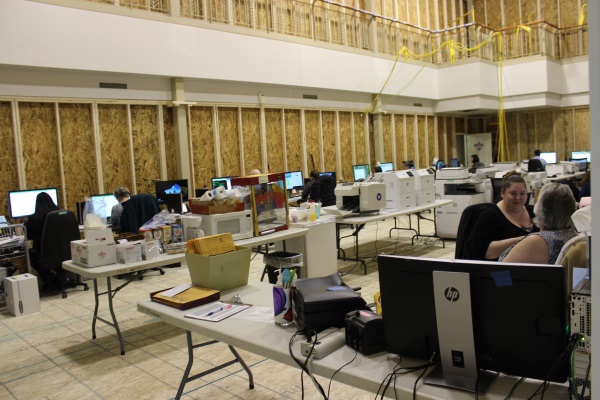Hammering, pounding, and sawing to transform Tribal Office Building’s roof and HVAC systems
By Ken Luchterhand

Anyone working in or visiting the Tribal Office Building in Black River Falls can tell you big changes are happening.
The atrium has been walled off, limiting access to just construction workers. However, recently members of the Treasury Department have taken up residence in the center.
Before the Treasury Department moved in, chipboard panels were placed on the atrium floor to protect the tiles, and then panels were erected vertically around the perimeter, creating a tunnel effect for employees to walk around the outside edges.
The pounding and sawing commenced soon afterward, disassembling the light translucent panels on the roof and inside lighting and trim. Soon, a new roof and trusses were in place, making it suitable for occupancy by Treasury employees.
Simmons Construction of Holmen is performing the work. The projected completion date is Sept. 1.
“The project is to remove ductwork, HVAC and heat pumps,” said John Steindorf, Administration Department executive director. “They’ll put in brand new heat pumps, boilers and duct work. It’ll be a brand new HVAC system.”
To complete the changeover, the project will be broken down into four parts. The first will be the top east quarter of the TOB, then the top west, lower east and finally the lower west quarter.
Departments will be relocated as needed as the project progresses. The employees will be temporarily located in the old District 1 Community Center, the American Legion building, the cafeteria, the IT Department, the Legislative Conference Room, and the atrium. The dates and sites are listed on the Ho-Chunk Nation website.
Some employees voiced displeasure in the removal of the skylight, which allowed filtered natural sunlight to enter the building, however, the panels have been up for more than 20 years and have become very brittle, posing a potential safety hazard. In addition, there were many leaks, requiring catch pans to be located in precise locations throughout the building whenever it rained.
“It wasn’t very energy efficient,” Steindorf said. “In the summer, we would gain heat and in the winter we’d lose a lot of heat.”
The HVAC system wasn’t designed for the present building configuration, Steindorf said. It was designed for an open office arrangement without walls between departments or offices. The original design was to have no divider walls, only cubical, therefore allowing the free flow of air. Walls were added after the building had been completed. The present structure, with walls, inhibits air movement.
“That’s why you will have some departments where employees are too hot, yet in other sections they are too cold. Air is not circulating the way it should,” he said. “The new system will allow better regulation of heat and cold air.”
“It would have taken a lot longer if we were to only work on one department at a time. It would have taken the project into December,” Steindorf said.
In addition, construction crews will be rebuilding the structures around windows. At present, water is flowing into the window frames and supportive structure, causing it to swell and rot. That is why many drafts current come from window structures.
All the ceiling panels are being replaced as well. They are made of a porous material, allowing air to flow through them, but they have become plugged with dust and detritus. New tiles will allow for better air flow.
In the atrium, the roof has been assembled and put into place. From the inside, a drop-down ceiling will be constructed featuring a myriad of lights.
“It will be brighter in the atrium, when they get done, than it was with the skylights,” Steindorf said.
The construction crew are actually ahead of schedule in completing the project.
Treasury Department employees are now adjusting to their new environment in the atrium.
The big move came Tuesday night, April 17, when IT (Information Technology Department) moved all the computers to tables downstairs and on the east half of the atrium, said Treasury Department Finance Director Rose Adams.
“We came in to work on Wednesday and they were already in,” Adams said.
“We were going to move to the former District 1 Community Center, but the move would have made it more difficult for us to process checks from Legislature, plus having access to documents.”
The Office of the President (OOP), Personnel and Insurance moved out, providing access of the upper eastern half of the building to construction workers.
They have been working at a rapid pace, removing the all the heating and cooling ductwork and heat pumps located in the ceilings.
EO Johnson, an office machine supplier, came in and moved the copy machines to the center of the atrium for Treasury use. The staff moved their own boxes of documents and office supplies, Adams said.
While Treasury Department’s relocation is in place, anyone visiting should use the door near the front of the building, next to the Security desk.
“It was smooth. IT took care of us,” Adams said.
When the project has been completed, there will be some changes that will affect all employees and tribal members when visiting the Treasury Department.
They are moving the HVAC unit that was located behind the door directly to the side of the Treasury Department main door. In turn, that newly-acquired door will be the main entrance for anyone other than Treasury employees, Adams said. Treasury employees will use the present door, but will be secure and require the use of their badges to enter.
Until the project has been finished, Treasury employees will continue their duties. Even with the changes, there will be one aspect that hasn’t changed.
“We still make popcorn,” Adams said. “We made sure to move the popcorn machine with us.”
Home